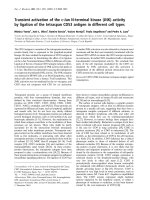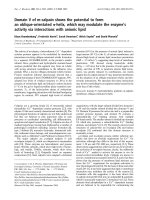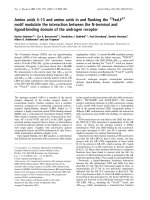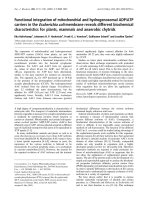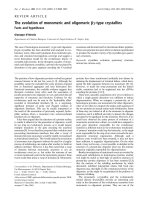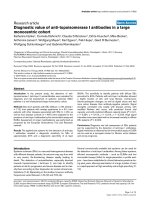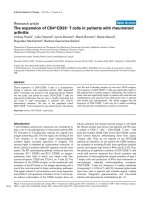Báo cáo Y học: Fluorescent analogs of UDP-glucose and their use in characterizing substrate binding by toxin A from Clostridium difficile pdf
Bạn đang xem bản rút gọn của tài liệu. Xem và tải ngay bản đầy đủ của tài liệu tại đây (414.22 KB, 8 trang )
Fluorescent analogs of UDP-glucose and their use in characterizing
substrate binding by toxin A from
Clostridium difficile
Sudeep Bhattacharyya, Amy Kerzmann and Andrew L. Feig
Department of Chemistry, Indiana University, Bloomington, IN, USA
Uridine-5¢-diphospho-1-a-
D
-glucose (UDP-Glc) is a com-
mon substrate used by glucosyltransferases, including
certain bacterial toxins such as Toxins A and B from
Clostridium difficile. Fluorescent analogs of UDP-Glc have
been prepared for use in our studies of the clostridial toxins.
These compounds are related to the methylanthraniloyl-
ATP compounds commonly used to probe the chemistry of
ATP-dependent enzymes. The reaction of excess methylisa-
toic anhydride with UDP-Glc in aqueous solution yields
primarily the 2¢ and 3¢ isomers of methylanthraniloyl-UDP-
Glc (MUG). As the 2¢ and 3¢ isomers readily interconvert,
this isomeric mixture was copurified by HPLC away from
the other isomeric products, and was characterized by a
combination of NMR, fluorescence and mass spectrometric
methods. TcdA binds MUG competitively with respect to
UDP-Glc with an affinity of 15 ± 2 l
M
in the absence of
Mg
2+
. There is currently no evidence that the fluorescent
substrate analog is turned over by the toxin in either gluco-
syltransferase or glucosylhydrolase reactions. Using a com-
petition assay, the affinity of UDP-Glc was determined to be
45±10 l
M
in the absence of Mg
2+
. The binding of UDP-
Glc and Mg
2+
are highly coupled with Mg
2+
affinities in the
range of 90–600 l
M
, depending on the experimental condi-
tions. These results imply that one of the significant roles of
the metal ion might be to stabilize the enzyme–substrate
complex prior to initiation of the transferase chemistry.
Keywords: fluorescence; Clostridium difficile;toxinA;
UDP-glucose; glucosylhydrolase.
Clostridium difficile is a bacterium that causes antibiotic-
associated diarrhea and pseudomembranous colitis [1–3].
Although C. difficile infection is widespread throughout the
population, clinical manifestation of C. difficile associated
diseases (CDAD) generally only occurs during antibiotic
therapy due to the inability of this organism to compete
against the other intestinal flora for nutrients [4]. C. difficile
excretes two large toxins that have been linked to its
pathogenicity, Toxin A (TcdA, P16154, molecular mass
308 kDa) and Toxin B (TcdB, P18177, molecular mass
270 kDa) [5]. Both toxins are glucosyltransferases and act
upon the Rho subfamily of small GTPases (RhoA, Cdc42
and Ras) [6,7]. Glucosylation of these G-proteins at a key
threonine residue initiates a cascade of events leading to
actin filament depolymerization and, ultimately, cell-round-
ing and cell death [8,9]. The glucose donor for both toxins is
UDP-glucose (UDP-Glc) [10]. In the absence of a suitable
protein acceptor, the toxins catalyze the simple hydrolysis of
UDP-Glc to UDP and free glucose (Scheme 1) [6,11].
The molecular biology and domain structure of these
toxins has been studied previously [12,13]. TcdA and TcdB
share 43% homology and 63% similarity and are
members of a family of cytotoxins known as the large
clostridial cytotoxins that also contains the lethal toxin from
C. sordellii and the a-toxin from C. novyi [12]. Deletion
experiments confirmed that the glucosyltransferase activity
resides in an N-terminal domain of 660 amino acids [14].
The C-terminal domain, on the other hand, is responsible
for interacting with a carbohydrate receptor on the surface
of intestinal endothelial cells and cellular uptake of the
toxin. A central hydrophobic region has been implicated in
toxin escape from the endosome [15].
The catalytic domain of the toxin shares common
features with a number of other glycosyltransferases. The
nucleotide-binding region contains two conserved elements.
The first is a tryptophan residue (W101 in TcdA) believed
to assist in substrate recognition through interaction with
the uridine group of UDP-Glc [16]. A second common
feature to many glycosyltransferases is a DXD motif
involved in binding a catalytically essential metal ion
cofactor [17]. Comparative sequence alignments have
identified D285 and D287 in TcdA as the aspartate
residues of this motif [17]. Glycosyltransferases commonly
employ Mg
2+
and/or Mn
2+
cofactors in their catalytic
mechanisms and these toxins follow that paradigm [18].
Previous studies found the toxins to contain iron and zinc
cofactors as well, but it is still unclear what role(s) these
other cofactors might play [11]. Mechanistic studies of the
glucosylhydrolase activity showed that Mg
2+
or Mn
2+
could stimulate activity and that K
+
also was required for
enzyme activation [11].
Correspondence to A. Feig, Department of Chemistry, Indiana
University, 800 E. Kirkwood Ave., Bloomington, IN 47405, USA,
Fax: + 1 812 855 8300, Tel.: + 1 812 856 5449,
E-mail:
Abbreviations: CDAD, Clostridium difficile associated disease; TcdA,
C. difficile Toxin A; TcdB, C. difficile Toxin B; MeCN, acetonitrile;
MUG, 2¢/3¢-methylanthraniloyl-uridine-5¢-diphospho-1-a-
D
-glucose,
BGT, T4 phage b-glucosyltransferase.
Proteins and enzymes: C. difficile toxin A (P16154); C. difficile toxin B
(P18177); RhoA (P06749); Cdc42 (P25763).
Note: a website can be found at />personnel/faculty/feig/feig.htm
(Received 15 February 2002, revised 14 May 2002,
accepted 23 May 2002)
Eur. J. Biochem. 269, 3425–3432 (2002) Ó FEBS 2002 doi:10.1046/j.1432-1033.2002.03013.x
A common assay for the kinetic study of enzymatic
UDP-Glc hydrolysis uses
14
C-nucleotide sugar complexes
and employs anion exchange chromatography to separate
the substrate and products [11]. This assay has been
instrumental in studying the mechanism of glucosylhydro-
lase activity, but has several disadvantages, including the
discontinuous nature of the data collection. We have
therefore synthesized a series of fluorescent analogs of the
nucleotide sugar complexes for use in studying glycosyl-
transferases in general and TcdA in particular. These
substrate analogs are related to the commercially available
methylanthraniloyl (mant) derivatives of ATP and GTP
commonly used in mechanistic studies of ATPases and
GTPases. Here, we report the synthesis, purification and
characterization of methylanthraniloyl-UDP-Glc (MUG),
and binding studies of this fluorophore to TcdA. We have
also used this fluorophore to probe the interaction of TcdA
with Mg
2+
and UDP-Glc.
MATERIALS AND METHODS
Unless otherwise stated, all reagents were used without
further purification. UDP-Glc, KCl, Hepes and dithiothre-
itol were purchased from Sigma. UDP-[U-
14
C]glucose
(320 mCiÆmmol
)1
)and[U-
14
C]glucose (3 mCiÆmmol
)1
)
were purchased from Amersham Pharmacia Biotech,
USA. AG1-X2 ion exchange resin was obtained from Bio-
Rad. Crude methylisatoic anhydride, obtained from Ald-
rich, was recrystallized twice from hot acetone prior to use.
C. difficile toxin A (TcdA) was purchased from Tech
Laboratory, Blacksburg, VA, USA. Solvents used for
organic synthesis were reagent grade or better. Microcon
filters with Ultracel-YM cellulose membranes (NMWL
10 000) were obtained from Millipore. RhoA and Cdc42
were prepared as GST fusion proteins, the clones for which
were supplied by R. Cerione, Cornell University, Ithaca,
NY, USA, and A. Bender, Indiana University, Blooming-
ton, USA, respectively, and purified by affinity chromatog-
raphy as previously described [19]. All buffers were prepared
from the appropriate free acid and adjusted to the correct
pH with KOH unless otherwise indicated.
Glucosylhydrolase activity assays
The glucosylhydrolase activity of TcdA was measured to
ensure that the enzyme used in the spectroscopic studies was
active. This assay is modeled after one previously reported
by Ciesla & Bobak, but converted to batch mode [11]. In
these studies, 100-lL reactions containing 50 m
M
Hepes
pH 7.0, 150 m
M
KCl, 1 m
M
dithiothreitol, 100 l
M
UDP-
Glc (2 mCiÆmmol
)1
), and 10 m
M
MnCl
2
were incubated in
the presence or absence of TcdA (100 lgÆmL
)1
)at37°C.
Aliquots (10 lL) were removed and quenched into 10 lLof
20 m
M
EDTA, pH 8.0. From this quenched reaction, 2 lL
was set aside for determination of total counts while the
remaining 18 lL were added to 150 lLofAG1-X2resin
beads (as a slurry made with 50 m
M
Hepes, pH 7.8) and
1mLof50m
M
Hepes, pH 7.8. These samples were allowed
to equilibrate at 4 °C on a rotary mixer and then the ion
exchange resin was separated by centrifugation (2700 g for
15 s). The amount of product ([
14
C]glucose) was then
quantitated by liquid scintillation counting and the results
are reported as the percent of the total counts in the
quenched aliquot. Assays were typically run in triplicate and
all data were corrected for the background hydrolysis of
UDP-Glc in the absence of toxin. Inhibition studies were
performed by varying the MUG and UDP-Glc concentra-
tions and following the kinetics of the hydrolysis reaction.
Synthesis of MUG, a triethylammonium salt
This material was prepared essentially as described previ-
ously [20]. Briefly, 30 mg (0.05 mmol) of UDP-Glc was
dissolved in 400 lL of distilled water and the pH of this
solution was raised to 9.3 with 2
M
NaOH solution. An
excess of methylisatoic anhydride (30 mg, 0.17 mmol) was
dissolved in 1.2 mL of dioxane and was added to the UDP-
Glc solution. The suspension was stirred for 45 min at room
temperature while being monitored by TLC (pre-Coated
Plastic-Backed TLC sheets 250 lm, solvent system:
NH
4
OH/n-propanol/H
2
O ¼ 1 : 2 : 7, UV detection), and
then filtered through a fritted glass disk. The solvent was
removed from the filtrate under vacuum leaving an off-
white solid. The crude product was resuspended in 800 lL
of water, filtered though UNIFLO 0.45 l
M
syringe filters
andstoredat)20 °C pending purification.
The desired product was purified from the reaction
mixturebyreversed-phaseHPLCbyusingaBeckman
ultrasphere semipreparative (10 mm · 25 cm) C18 column
installed in a Waters 600 gradient controller and connected
to a Waters 2486 dual-wavelength absorbance detector and
a fraction collector. A triethylammonium/acetate buffer
system was used together with an acetonitrile gradient for
the HPLC purification. Buffer A consisted of 10 m
M
triethylammonium/acetate (10 m
M
triethylamine in water
adjusted to pH 5.5 with acetic acid) whereas buffer B was
10 m
M
triethylammonium/acetate, pH 5.5 in 90% MeCN.
Purification was achieved with a four-step gradient
program: 0–5 min, 94 : 6 (%A/%B); 5–13 min, linear
gradient to 55 : 45; 13–50 min, linear gradient to 45 : 55;
50–75 min, linear gradient to 0 : 100. Products were
detected by simultaneous monitoring at A
260
and A
330
,
Scheme 1.
3426 S. Bhattacharyya et al. (Eur. J. Biochem. 269) Ó FEBS 2002
and the 2¢/3¢ mixture eluted at a retention time of 15 min.
Solvents from the eluted fractions were removed under
reduced pressure without heating. The final purified yield
was 10 mg (20%). A 10 m
M
stock solution of this product
was prepared; the pH was adjusted to 6.5, and the material
was stored at )20 °C. The purified product was character-
ized by NMR: 2¢-MUG
1
H-NMR (D
2
O): d ¼ 6.5–8.0 (m,
4H, Ar-H), 5.8–6.1 (m, 1H, H-1¢ ), 5.3–5.5 (m, 2H, H-1¢,
H-5), 4.4–4.6 (m, 1H, H-2¢ ), 4.0–4.3 (m, 3H, H-3¢,H-4¢,
H-5¢), 3.5–3.8 (m, 3H, H-3¢,H-5¢,H-6¢), 3.2–3.4 (m, 2H,
H-2¢,H-4¢), 2.75 (s, 1H, N-CH
3
); 3¢-MUG
1
H-NMR (D
2
O):
d ¼ 7.8–8.0 (2H, Ar-H, H-6), 7.35–7.45 (1H, Ar-H), 6.65–
6.80 (1H, Ar-H), 6.55–6.65 (1H, Ar-H), 6.05 (d,1H, H-1¢),
5.7–5.8 (1H, H-5), 5.3–5.5 (2H, H-3¢,H-1¢ ), 4.4–4.6 (2H,
H-2¢,H-4¢), 4.0–4.3 (2H, H5¢ ), 3.5–3.8 (4H, H-3¢,H-5¢,
H-6¢), 3.2–3.4 (2H, H-2¢,H-4¢ ), 2.75 (s, 3H, N-CH
3
);
31
P-NMR (D
2
O):d ¼ )10.8 (d, 1P, aP); )12.5 (d, 1P, bP).
MALDI-TOF mass spectrometry, UV/Vis and fluorescence
further verified that we had the appropriate material:
MS (MALDI-TOF matrix: 2,5-dihydroxybenzoic acid)
m/z ¼ 697.8 (calc. M
2–
¼ 697.4). UV(D
2
O) k(absorp-
tion) ¼ 358 nm (e ¼ 1500
M
)1
Æcm
)1
). Fluorescence: k
ex
¼
358 nm, k
em
¼ 440 nm. At equilibrium (25 °C), the 2¢/3¢
isomer ratio is approximately 1 : 1.2 based on integration of
the NMR signal derived from the N-methyl groups of the
methylanthraniloyl group.
Enzyme manipulation
Initial toxin stocks were prepared phosphate-buffered saline
at concentrations of 1.0–1.35 mgÆmL
)1
andanalyzedby
SDS/PAGE to ensure homogeneity. Buffer exchange was
performed at 4 °C by three cycles of 10-fold concentration
in Microcon filter units (Ultracel-YM cellulose membrane,
NMWL 10 000) and re-dilution into the assay buffer, after
which the protein containing retentate was removed from
the filtration unit. For spectroscopic studies that required
high concentrations of toxin, the protein was left in its
concentrated form after the final centrifugation step.
Subsequent protein concentrations were measured by using
the Bio-Rad Protein Assay following the manufacturer’s
protocol standardized against BSA. Typically, greater than
90% of the toxin was recovered after buffer exchange and
concentration.
Fluorescence measurements
All fluorescence measurements were performed in a Perkin-
Elmer LS50B luminescence spectrometer using microvol-
ume fluorescence cuvettes. Initial studies of MUG
fluorescence were performed at 50 n
M
MUG in 50 m
M
Hepes, pH 7.6 and 150 m
M
KCl. Binding titrations were
performed in solutions containing 50 n
M
MUG in 50 m
M
Hepes, pH 7.6, 150 m
M
KCl, and 1 m
M
dithiothreitol.
Under these conditions, the fluorescence intensity of free
MUG was negligible compared to that of the enzyme
complex. During these titrations, the concentration of
MUG was held constant while the concentration of the
toxin was varied between 0 and 28.4 l
M
. The initial sample
contained 28.4 l
M
TcdA. This sample was then serially
diluted with a buffer containing all components except the
toxin to avoid dilution artifacts. Samples were equilibrated
for 10 min at 4 °C after which time, the fluorescence
intensities were measured and averaged over five scans.
Data were analyzed by nonlinear least squares curve-fitting
to standard binding isotherms by using the program
KALEIDAGRAPH
(Synergy Software). Similar titration strat-
egies were used to obtain data over a wide range of Mg
2+
concentrations without dilution of either the toxin or the
fluorophore.
Competitive binding between MUG and UDP-Glc was
observed under similar experimental conditions. Solutions
of 50 n
M
MUG and 0.4 l
M
TcdA in 50 m
M
Hepes, pH 7.6
and 150 m
M
KCl containing varying concentrations of
UDP-Glc (0–145 m
M
) were studied. The variable concen-
trations of UDP-Glc were obtained by starting with a stock
solution containing all of the components including 145 m
M
UDP-Glc. This solution was then serially diluted with a
second solution, identical to the first, except that it
contained no UDP-Glc. Samples were mixed manually in
the cuvettes at 4 °C and allowed to equilibrate for 10 min
prior to analysis of MUG fluorescence emission at 440 nm
(358 nm excitation). As the metal ion cofactor is missing
from these samples, no significant toxin-catalyzed UDP-Glc
hydrolysis should have occurred during these experiments.
RESULTS AND DISCUSSION
Synthesis of fluorescent UDP-Glc analogs
The methylanthraniloyl derivatives of nucleotides such as
ATP and GTP have been used extensively as fluorescent
analogs in the study of nucleotide binding sites on proteins
[21–23]. Surprisingly, however, the related compounds
have not been used to probe enzymes that use nucleotide
diphosphate sugars complexes. The synthesis of the
fluorescently-labeled UDP-Glc was carried out by modify-
ing a preparative method for similar molecules, as
described previously [20]. The coupling was achieved by
combining a stoichiometric excess of methylisatoic anhy-
dride with a solution of UDP-Glc held at pH 9.3. The
reaction between ribose sugar alcoholic group(s) with the
anhydride yields the desired product (Scheme 2) together
with several isomeric byproducts. The 2¢,3¢ and 6¢¢
modified UDP-Glc were the dominant products of the
reaction, as predicted from previous computational studies
[20]. This differential reactivity made it unnecessary to
protect the glucose moiety prior to derivatization, thus
providing an extremely simple and efficient route to these
substrate analogs.
Reverse-phase HPLC purification resolved the isomers
present in the reaction mixture. The major fractions were
subsequently identified by NMR analysis. The differential
reactivity predicted in the previously mentioned study [20]
was observed, showing three major isomers of the desired
MUG, due to 2¢-and3¢-and6¢¢ -ester products. In solution,
the 2¢-and3¢-derivatives readily interconvert with each
other resulting in an equilibrium mixture (1 : 1.2 ratio at
25 °C) of these two products after purification. In the case
of mant-ATP and mant-GTP, the 2¢ and 3¢ isomers can
sometimes be resolved and used independently prior to re-
equilibration [24–27]. Such experiments are possible with
MUG, but no attempt was made to achieve this level of
separation. The purified reaction product was stable in
aqueous solution at moderate pH (6–7) and was stored as a
10 m
M
stock solution (pH 6.5) at )20 °C.
Ó FEBS 2002 Fluorescent UDP-Glc analogs (Eur. J. Biochem. 269) 3427
Toxin activity studies
Toxin activity was verified by using several kinetic assays,
including a procedure modeled after the studies of Ciesla &
Bobak [11]. They employed an assay based on ion exchange
chromatography to separate unreacted UDP-[U-
14
C]Glc
and UDP from [U-
14
C]Glc followed by quantitation by scin-
tillation counting. Our assay is fundamentally the same
except that it uses a batch mode format to facilitate working
with many samples simultaneously. In these studies, TcdA
was capable of turning over at a rate of 32 ± 3 (mol UDP-
Glc)Æ(mol TcdA)
)1
Æh
)1
under our standard conditions
(Scheme 1). Our activities were slightly higher than that
reported previously [19 (mol UDP-Glc)Æ(mol TcdA)
)1
Æh
)1
under similar conditions], but the results are otherwise quite
comparable [11]. Similar studies employing
31
P-NMR that
follow the formation of UDP also allowed determination of
glucosylhydrolase activity by UDP-Glc (data not shown).
This latter assay was useful for assessing whether the enzyme
could turnover the substrate analog without resorting to the
synthesis of methylanthraniloyl-modified UDP-[U-
14
C]Glc.
No evidence for glucosylhydrolase activity of MUG was
detected (probed out to 5 days). Furthermore, MUG acts as
a very weak competitive inhibitor (K
i
¼ 400±100 l
M
at
37 °C) with respect to UDP-Glc.
Florescence properties of MUG and the TcdA–MUG
complex
The excitation and emission spectra of MUG are shown in
Fig. 1A. As expected, this compound is highly fluorescent
and yields excitation and emission spectra quite similar to
the parent mant-ATP compound after which it was
modeled [21]. Binding of MUG to TcdA leads to significant
changes in the emission spectrum (Fig. 1B). The fluores-
cence intensity of the 50 n
M
MUG solution increases more
than 20-fold upon binding to TcdA. In addition, the
emission maximum undergoes a 10-nm blue shift. Finally,
the transition at 410 nm in the emission spectrum is
obscured by the dominant 440 nm peak in the spectrum
of the protein-bound MUG. When RhoA or Cdc42 are
added to solutions of MUG in the absence of TcdA, no
spectral changes are observed. Therefore, the observed
fluorescence changes are the result of a specific interaction
between the substrate analog and the toxin. These spectral
differences provide a convenient handle with which to
measure the affinity of the toxin for the fluorescent substrate
analog (K
MUG
).
In the presence of a fixed concentration of MUG, TcdA
was titrated into the sample in great excess of the
fluorophore (Fig. 2). This methodology avoids potential
complications due to changes in the concentration of the
fluorophore and hence simplifies the data analysis. These
studies showed that MUG binds to the toxin with an affinity
of 15 ± 2 l
M
at 4 °C. The 15 l
M
binding affinity is similar
in magnitude to the 6 l
M
K
d
measured for UDP-Glc
binding to the related C. sordellii lethal toxin (catalytic
domain) at 25 °C by intrinsic fluorescence [28]. The affinity
of the modified substrate is therefore well within the range
one might expect for binding to the natural substrate. Due
to the large size of the holotoxin and the numerous
tryptophan residues, intrinsic fluorescence experiments to
Scheme 2.
Fig. 1. Relative fluorescent intensity of MUG. (A) Excitation and
emission spectra of 50 n
M
MUG in 50 m
M
Hepes, pH 7.6, 150 m
M
KCl, 1 m
M
dithiothreitol. (B) Fluorescence emission spectra of 50 n
M
MUG alone (d) or in the presence of 0.4 l
M
TcdA (j)or0.4l
M
TcdA and 10 m
M
MgCl
2
(m). All three samples were prepared in
50 m
M
Hepes, pH 7.6, 150 m
M
KCl, 1 m
M
dithiothreitol. The exci-
tation scan was collected while monitoring emission at 440 nm and
emission data were collected with 358 nm excitation.
3428 S. Bhattacharyya et al. (Eur. J. Biochem. 269) Ó FEBS 2002
look at the binding of the natural UDP-Glc substrate were
not attempted.
Competitive binding studies were performed with the
natural UDP-Glc substrate to ensure that binding occurred
in the active site. Addition of UDP-Glc to the MUG–TcdA
complex results in a decrease of fluorescent intensity due to
displacement of MUG from the active site (Fig. 3). This
finding corroborates the fact that these molecules bind in
competitive fashion in the active site pocket and probes the
equilibrium constant
MUG
K
UDP-Glc
. A plot of the fluores-
cence intensity vs. [UDP-Glc] can therefore provide infor-
mation on the affinity of UDP-Glc for the toxin, expressed
as the ratio of the two dissociation constants. As the K
MUG
value was measured independently, we can estimate the
apparent affinity of the toxin for UDP-Glc (K
UDP-Glc
),
yielding a value of 45±10 l
M
. This value is about threefold
lower than the K
m
value (142 l
M
) that has been measured
under similar conditions with the exception that Mg
2+
was
present in the kinetics measurement [11].
Two oddities derive from the analysis of these data. The
first is that in the absence of Mg
2+
, MUG actually binds
more tightly than UDP-Glc. This increased affinity almost
certainly comes from additional hydrophobic interactions in
the active site due to the large methylanthraniloyl group that
is being sequestered. It should be noted that this binding is
being monitored in the absence of the Mg
2+
/Mn
2+
cofactors. On the other hand, the inhibition data mentioned
above (K
i
¼ 400 l
M
) showed that MUG is a rather poor
competitive inhibitor; data collected in the presence of
saturating concentrations of the metal cofactor. Together,
these data are indicative of two modes of substrate binding
(i.e. open and closed). The closed, active form of UDP-Glc
binding is only observed in the presence of the metal ion that
properly aligns the UDP-Glc in the active site. The
unfavorable steric interactions deriving from the presence
of the fluorescent tag on the ribose 2¢/3¢ position might
preclude proper orientation in the tight binding (closed) and
catalytically active conformation. Therefore, we began to
probe the affect metal binding on substrate affinity.
The initial fluorescence studies were performed in the
absence of either Mg
2+
or Mn
2+
, but enzyme activity
requires one or both of these ions to be present. The
addition of Mg
2+
up to 10 m
M
concentration has a
significant effect on the fluorescence intensity of the
TcdA–MUG complex, allowing us to probe the interaction
between the metal cofactor and the TcdA–MUG complex.
In the absence of TcdA, the addition of Mg
2+
has no effect
on the fluorescence intensity of MUG, so the change in
fluorescence is a result of forming the TcdA–MUG–Mg
2+
ternary complex. A titration curve for the binding of Mg
2+
to the TcdA–MUG complex is shown in Fig. 4, yielding an
apparent affinity (
MUG
K
Mg
)of90±10l
M
for the metal
ion cofactor in the presence of 0.4 l
M
TcdA. Scatchard
analysis of the data shows no indication of additional
complexities such as multiple binding sites. When this
experiment is repeated in the presence of higher concentra-
tions of TcdA, the apparent affinity for Mg
2+
decreases
significantly with an affinity of 600 l
M
measured at 2 l
M
TcdA. The real affinity is probably even slightly weaker
than that, as the 2 l
M
concentration of TcdA was insuffi-
cient to saturate MUG binding.
Based on our data, we can draw a thermodynamic cycle
that represents the binding of TcdA to MUG, UDP-Glc
and Mg
2+
. This cycle is shown in Fig. 5. In the simplest
case, one might have expected independent binding of
Mg
2+
and MUG(UDP-Glc) to TcdA. This statement is
equivalent to saying that
UDP-Glc
K
Mg
¼
MUG
K
Mg
¼ K
Mg
,
as defined in Fig. 5. Two outcomes to that argument
must also be true in the case of independent binding:
K
MUG
¼
Mg
K
MUG
and K
UDP-Glc
¼
Mg
K
UDP-Glc
.Hadthis
Fig. 3. Plot showing the decrease in relative fluorescence intensity of
MUG (50 n
M
) bound TcdA (0.43 l
M
) upon addition of UDP-Glc
(0–145 m
M
). Experimental conditions: 50 m
M
Hepes, pH 7.6, 150 m
M
KCl, 1 m
M
dithiothreitol, 4 °C, k
ex
¼ 358 nm, k
em
¼ 440 nm.
Fig. 2. MUG fluorescence in the presence of TcdA. (A) Titration of
50 n
M
MUG with TcdA (0–28.4 l
M
) monitored by fluorescence emis-
sion. Experimental conditions: 50 m
M
Hepes, pH 7.6, 150 m
M
KCl,
1m
M
dithiothreitol, 4 °C, k
ex
¼ 358 nm, k
em
¼ 440 nm; (B) Plot of
fluorescence intensity vs. [TcdA] fit to a standard binding isotherm.
Experimental conditions: 50 n
M
MUG, buffer 150 m
M
KCl, 50 m
M
Hepes, pH 7.6, 1 m
M
dithiothreitol, 4 °C, k
ex
¼ 358 nm,
k
em
¼ 440 nm.
Ó FEBS 2002 Fluorescent UDP-Glc analogs (Eur. J. Biochem. 269) 3429
been the case, we would have measured the same Mg
2+
affinity regardless of the TcdA concentrations, as the metal
binding event would be totally independent of the interac-
tions involved in the enzyme–substrate complex. The
binding of MUG and Mg
2+
are not independent, however,
but instead are highly coupled to one another. It is likely
that by analogy, there is coupled binding between the metal
ion cofactor and the natural UDP-Glc substrate. Magne-
sium appears to bind more weakly to the TcdA–MUG
complexthantofreeTcdA(K
Mg
£ 90 l
M
,whereas
MUG
K
Mg
‡ 600 l
M
). Using the limits obtained in the
experiment shown in Fig. 4 and the thermodynamic cycle
in Fig. 5, we can set the limit that
Mg
K
MUG
£ 100 l
M
.
These data suggest that an ordered mechanism is involved in
the reaction chemistry, a feature that can be assessed in
future studies through detailed kinetic analysis of the
hydrolase and transferase reactions.
Previous studies showed the importance of the metal ion
cofactor for activity, but provided only an upper limit
(<2m
M
) on the actual affinity [11]. In that study, they also
showed that the K
m
for UDP-Glc was weakly affected by
binding of the metal ion cofactor. In our studies, the
thermodynamic cycle lets us define a lower limit of 1 m
M
for
the affinity of the TcdA–UDP–Glc complex for Mg
2+
.
Thus, the Mg
2+
affinity is now narrowly bound by these
two studies. The thermodynamic scheme presented in Fig. 5
is fully consistent with the data of Ciesla & Bobak [11] as
well as that presented here. The main interpretation of this
thermodynamic scheme is that the presence of the metal
cofactor helps maintain the integrity and stability of
enzyme–substrate complex. It is therefore likely that the
ion simultaneously interacts with both the enzyme and
UDP-Glc in the active site and that the glucosyl donor
becomes realigned in the active site as a result of its contacts
with the Mg
2+
cofactor, thus affecting its affinity.
One major difficulty commonly encountered in studying
Mg-dependent enzymes is the lack of convenient spectro-
scopic handles that can be used to probe directly the Mg
2+
binding to TcdA [29]. Mg
2+
binding to free TcdA is
invisible to our assays. Thus, in this study, we have resorted
to looking at the effects of Mg
2+
binding on the other
relevant equilibria. On-going studies using Mn
2+
EPR
methods and phosphorothioate derivatives of UDP-Glc will
allow another look at these coupled processes and provide
further details on the interaction of UDP-Glc, TcdA and the
metal ion cofactor.
In vivo, TcdA catalyzes the transfer of glucose from UDP-
Glc to a threonine residue of its acceptor protein
(Scheme 1). The affinities of TcdA for these acceptors have
not been measured carefully, but kinetic studies show
efficient glucosyl transfer in the presence of 1 l
M
acceptor.
Addition of either GST–Cdc42 or GST–RhoA (up to
1.5 l
M
) induced only minor changes in the fluorescence
spectrum. It is therefore not practical to measure the
affinities of the acceptor using MUG fluorescence. The most
likely reason for this result is that the binding of the acceptor
does not significantly alter the environment around the
methylanthraniloyl group that is already protected from
solvent in the TcdA–MUG complex.
Comparison of the UDP-Glc binding pockets of several
structurally characterized glycosyltransferases, such as SpsA
Bacillus subtilis [30], LgtC from Neisseria meningitidis [31],
T4 bacteriophage DNA b-glucosyltransferases (BGT)
[32,33] and UDP-galactose:b-galactosyl a-1,3-galactosyl-
transferase (a3GT) [34], supports the idea that the glucose
acceptor might have only relatively minor effects on the
environment around the donor. In each case, the nucleotide
portion of the substrate is buried deep within the transferase
active site. A channel or cleft is available for the acceptor to
approach the glycosyl donor involved in the transferase
Fig. 5. Diagram showing the thermodynamic
equilibria and their dissociation constants
involved in the binding of UDP-Glc, MUG and
Mg
2+
to TcdA. Valuesshowninparentheses
have been obtained by using the thermody-
namic cycle and the equilibrium constants that
could be readily measured using inhibition
assays or fluorescence properties of MUG.
Values in square brackets were measured in
the kinetic studies of Ciesla & Bobak [11].
Values with neither parentheses nor brackets
have been measured directly in these studies.
Fig. 4. Plot of the fluorescence intensity vs. MgCl
2
concentration at 0.4
(d), 0.8 (j) and 2.0 (m) lM TcdA in the presence of 50 n
M
MUG,
150 m
M
KCl, 50 m
M
Hepes, pH 7.6 and 1 m
M
dithiothreitol at 4 °C,
k
ex
¼ 358 nm, k
em
¼ 440 nm. Data were fit to standard binding iso-
therms yielding apparent affinities of 100 ± 15, 350 ± 50,
630 ± 40 l
M
, respectively.
3430 S. Bhattacharyya et al. (Eur. J. Biochem. 269) Ó FEBS 2002
chemistry. All of the structures mentioned above have small
water-filled cavities adjacent to the 2¢-OH of the crystallo-
graphically observed UDP (or UDP-galactose in the case of
LgtC), and hence might accommodate the methylanthrani-
loyl modified substrate analog with only minor rearrange-
ments. To check this finding, 2¢-MUG was computationally
docked into the active sites of LgtC and BGT by using the
program
AUTODOCK
[35] followed by simulated annealing.
Little shift in the side chain positions (0.6 A
˚
rmsd for LgtC
and 0.4 A
˚
rmsd for BGT) was observed. Very similar to the
BGT-UDP crystal structure, the phosphodiester moiety of
MUG makes several good hydrogen bonding interactions
with positively charged arginine groups (R191, R195 and
R269) in the minimized structure, thereby stabilizing the
negative charge of MUG. The Mg
2+
ions in the active site
of TcdA might easily take the place of these basic residues in
the stabilization of the enzyme–substrate complex.
Recent studies of substrate and metal binding to T4
BGT show significant structural changes upon UDP/
UDP-Glc binding [33]. Addition of the Mg
2+
or Mn
2+
cofactor, on the other hand, induced only minor struc-
tural shifts despite the requirement of this cofactor for
activity. These structural studies suggested that the main
role of the metal cofactor was for the stabilization of an
oxocarbonium ion intermediate. Whereas this activity may
be part of the mechanistic role of the metal ion, it cannot
be the entire story. We have shown that Mg
2+
binding
alters the affinity of the enzyme for the UDP-Glc
substrate. If the role of this ion were only in the transition
state, this coupled binding would not be observed. The
role of Mg
2+
in this reaction therefore must also involve
stabilization of the enzyme–substrate complex. The loca-
tion of the metal ion cofactor with respect to the
nucleotide-sugar substrate varies in these structures. Most
commonly, it is observed bridging the a-andb-phospho-
ryl oxygen atoms of UDP or UDP-Glc [30,31,36]. This
mode of interaction is analogous to that observed in
many Enzyme–Mg–ATP complexes. In the case of
BGT, however, the Mg
2+
ion only interacts with the
b-phosphate. In each case, additional ligation to the metal
is provided by amino-acid side-chains such as those of the
DXD motif [17,37,38]. Continuing structural studies
coupled with biophysical and enzymatic analysis of these
enzymes should continue to improve our picture of how
these glucosyl transfer reactions occur and the role that
the metal ion cofactors play in stimulating this chemistry.
CONCLUSIONS
We have prepared a fluorescent analog of UDP-Glc and
used it as a spectroscopic probe to investigate the
mechanism of glucosyltransfer catalyzed by C. difficile
toxin A. This substrate analog binds competitively with
respect to the natural substrate but cannot be turned over
by the toxin. We have been able to probe the binding of
both the synthetic as well as the natural substrate through
our assays and have shown significant coupling between
the binding of UDP-Glc and the Mg
2+
cofactor. This
finding implies that one of the roles of this ion may be to
stabilize the TcdA–UDP-Glc complex prior to formation
of any mechanistic intermediates, such as an oxocarbo-
nium ion, that might lie along the reaction coordinate for
glucosyltransfer.
ACKNOWLEDGEMENTS
This work was generously supported by the Indiana University College
of Arts and Sciences and a grant to A. L. F. from the American
Chemical Society-Petroleum Research Fund (#35517-G4). A. K. was a
summer REU student supported by the site grant DBI-9987835 from
the National Science Foundation. We would like to thank Peter
Mikulecky for helpful comments on the manuscript.
REFERENCES
1. Bartlett, J.G., Chang, T.W., Moon, N. & Onderdonk, A.B. (1978)
Antibiotic-induced lethal enterocolitis in hamsters: studies with
eleven agents and evidence to support the pathogenic role of toxin-
producing Clostridia. Am. J Vet Res. 39, 1525–1530.
2. Bartlett, J.G., Moon, N., Chang, T.W., Taylor, N. & Onderdonk,
A.B. (1978) Role of Clostridium difficile in antibiotic-associated
pseudomembranous colitis. Gastroenterology 75, 778–782.
3. Jones, R.L. (2000) Clostridial enterocolitis. Vet Clin. North Am.
Equine Pract. 16, 471–485.
4. Itoh, K., Lee, W.K., Kawamura, H., Mitsuoka, T. & Magari-
buchi, T. (1987) Intestinal bacteria antagonistic to Clostridium
difficile in mice. Lab. Anim. 21, 20–25.
5. Wilkins, T., Krivan, H., Stiles, B., Carman, R. & Lyerly, D. (1985)
Clostridial toxins active locally in the gastrointestinal tract. Ciba
Found. Symp. 112, 230–241.
6. Just, I., Wilm, M., Selzer, J., Rex, G., von Eichel-Streiber, C.,
Mann, M. & Aktories, K. (1995) The enterotoxin from Clos-
tridium difficile (ToxA) monoglucosylates the Rho proteins. J. Biol.
Chem. 270, 13932–13936.
7. Just,I.,Selzer,J.,Wilm,M.,vonEichel-Streiber,C.,Mann,M.&
Aktories, K. (1995) Glucosylation of Rho proteins by Clostridium
difficile toxin B. Nature 375, 500–503.
8. Herrmann, C., Ahmadian, M.R., Hofmann, F. & Just, I. (1998)
Functional consequences of monoglucosylation of Ha-Ras at
effector domain amino acid threonine 35. J. Biol. Chem. 273,
16134–16139.
9. Hippenstiel, S., Tannert-Otto, S., Vollrath, N., Krull, M., Just, I.,
Aktories, K., von Eichel-Streiber, C. & Suttorp, N. (1997)
Glucosylation of small GTP-binding Rho proteins disrupts
endothelial barrier function. Am. J. Physiol. 272, L38–L43.
10. Chaves-Olarte, E., Florin, I., Boquet, P., Popoff, M., von Eichel-
Streiber, C. & Thelestam, M. (1996) UDP-glucose deficiency in a
mutant cell line protects against glucosyltransferase toxins from
Clostridium difficile and Clostridium sordellii. J. Biol. Chem. 271,
6925–6932.
11. Ciesla, W.P. Jr & Bobak, D.A. (1998) Clostridium difficile toxins A
and B are cation-dependent UDP-glucose hydrolases with differ-
ing catalytic activities. J. Biol. Chem. 273, 16021–16026.
12. Moncrief, J.S., Lyerly, D.M. & Wilkins, T.D. (1997) Molecular
biology of the Clostridium difficile toxins. The Clostridia: Mole-
cular Biology and Pathogenesis (Rood, J.I., McClane, B.A., Son-
ger, J.G. & Titball, R.W., eds), pp. 369–392. Academic Press, New
York.
13. Aktories, K., Selzer, J., Hofmann, F. & Just, I. (1997) Molecular
mechanism of action of Clostridium difficile toxins A and B. The
Clostridia: Molecular Biology and Pathogenesis (Rood, J.I.,
McClane, B.A., Songer, J.G. & Titball, R.W., eds), Academic
Press, New York.
14. Faust, C., Ye. B. & Song, K.P. (1998) The enzymatic domain of
Clostridium difficile toxin A is located within its N-terminal region.
Biochem. Biophys. Res. Commun. 251, 100–105.
15. Just, I. & Boquet, P. (2000) Large clostridial cytotoxins as tools in
cell biology. Curr. Top Microbiol Immunol. 250, 97–107.
16. Busch, C., Schomig, K., Hofmann, F. & Aktories, K. (2000)
Characterization of the catalytic domain of Clostridium novyi
alpha-toxin. Infect. Immun. 68, 6378–6383.
Ó FEBS 2002 Fluorescent UDP-Glc analogs (Eur. J. Biochem. 269) 3431
17. Busch, C., Hofmann, F., Selzer, J., Munro, S., Jeckel, D. &
Aktories, K. (1998) A common motif of eukaryotic glycosyl-
transferases is essential for the enzyme activity of large clostridial
cytotoxins. J. Biol. Chem. 273, 19566–19572.
18. Hendrickson, T.L. & Imperiali, B. (1995) Metal ion dependence of
oligosaccharyl transferase: implications for catalysis. Biochemistry
34, 9444–9450.
19. Zheng, Y., Glaven, J.A., Wu, W.J. & Cerione, R.A. (1996)
Phosphatidylinositol 4,5-bisphosphate provides an alternative to
guanine nucleotide exchange factors by stimulating the dissocia-
tion of GDP from Cdc42Hs. J. Biol. Chem. 271, 23815–23819.
20. Kim, K B., Behrman, E.C., Cottrell, C.E. & Behrman, E.J. (2000)
On the conformation of UDP-Glc, a sugar nucleotide. J. Chem
Soc. Perkin Transactions II, 677–682.
21. Jameson, D.M. & Eccleston, J.F. (1997) Fluorescent nucleotide
analogs: synthesis and application. Fluorescence Spectroscopy
(Brand, L. & Johnson, M.L., eds), pp. 363–390. Academic Press,
San Diego.
22. Jameson, D.M. & Sawyer, W.H. (1995) Fluorescence anisotropy
applied to biomolecular interactions. Methods Enzymol. 246,283–
300.
23. Jameson, D.M. & Eccleston, J.F. (1997) Fluorescent nucleotide
analogs: synthesis and applications. Methods Enzymol. 278,363–
390.
24. Cremo, C.R., Neuron, J.M. & Yount, R.G. (1990) Interaction of
myosin subfragment 1 with fluorescent ribose-modified nucleo-
tides. A comparison of vanadate trapping and SH1–SH2 cross-
linking. Biochemistry 29, 3309–3319.
25. Rensland, H., Lautwein, A., Wittinghofer, A. & Goody, R.S.
(1991) Is there a rate-limiting step before GTP cleavage by H-ras
p21? Biochemistry 30, 11181–11185.
26. Moore, K.J., Webb, M.R. & Eccleston, J.F. (1993) Mechanism of
GTP hydrolysis by p21N-ras catalyzed by GAP: studies with a
fluorescent GTP analogue. Biochemistry 32, 7451–7459.
27. Cheng, J Q., Jiang, W. & Hackney, D.D. (1998) Interaction of
mant-adenosine nucleotides and magnesium with kinesin. Bio-
chemistry 37, 5288–5295.
28. Busch, C., Hofmann, F., Gerhard, R. & Aktories, K. (2000)
Involvement of a conserved tryptophan residue in the UDP-
glucose binding of large clostridial cytotoxin glycosyltransferases.
J. Biol. Chem. 275, 13228–13234.
29. Feig, A.L. (2000) The use of manganese as a probe for elucidating
the role of magnesium ions in ribozymes. In Metal Ions in Biolo-
gical Systems, Vol. 37: Manganese and its Role in Biological
Processes (Sigel, H., & Sigel, A., eds) pp. 157–182. Marcel Dekker,
New York.
30. Charnock, S.J. & Davies, G.J. (1999) Structure of the nucleo-
tide-diphospho-sugar transferase, SpsA from Bacillus subtilis,in
native and nucleotide-complexed forms. Biochemistry 38,
6380–6385.
31. Persson, K., Ly, H.D., Dieckelmann, M., Wakarchuk, W.W.,
Withers, S.G. & Strynadka, N.C. (2001) Crystal structure of the
retaining galactosyltransferase LgtC from Neisseria meningitidis in
complex with donor and acceptor sugar analogs. Nat. Struct. Biol.
8, 166–175.
32. Morera, S., Imberty, A., Aschke-Sonnenborn, U., Ruger, W. &
Freemont, P.S. (1999) T4 phage beta-glucosyltransferase: sub-
strate binding and proposed catalytic mechanism. J. Mol. Biol.
292, 717–730.
33. Morera, S., Lariviere, L., Kurzeck, J., Aschke-Sonnenborn, U.,
Freemont, P.S., Janin, J. & Ruger, W. (2001) High resolution
crystal structures of T4 phage beta- glucosyltransferase: induced fit
and effect of substrate and metal binding. J. Mol. Biol. 311,569–
577.
34. Boix, E., Swaminathan, G.J., Zhang, Y., Natesh, R., Brew, K. &
Acharya, K.R. (2001) Structure of UDP complex of
UDP-galactose: beta-galactoside-alpha-1,3-galactosyltransferase
at 1.53-A
˚
resolution reveals a conformational change in the
catalytically important C terminus. J. Biol. Chem. 276, 48608–
48614.
35. Morris, G.M., Goodsell, D.S., Halliday, R.S., Huey, R., Hart,
W.E., Belew, R.K. & Olson, A.J. (1998) Automated docking using
a Lamarckian genetic algorithm and emperical binding free energy
function. J. Comput. Chem. 19, 1639–1662.
36. Unligil, U.M., Zhou, S., Yuwaraj, S., Sarkar, M., Schachter, H. &
Rini, J.M. (2000) X-ray crystal structure of rabbit N-acetyl-
glucosaminyltransferase I: catalytic mechanism and a new protein
superfamily. EMBO J. 19, 5269–5280.
37. Griffiths, G., Cook, N.J., Gottfridson, E., Lind, T., Lidholt, K. &
Roberts, I.S. (1998) Characterization of the glycosyltransferase
enzyme from the Escherichia coli K5 capsule gene cluster and
identification and characterization of the glucuronyl active site.
J. Biol. Chem. 273, 11752–11757.
38. Wiggins, C.A. & Munro, S. (1998) Activity of the yeast MNN1
alpha-1,3-mannosyltransferase requires a motif conserved in many
other families of glycosyltransferases. Proc. Natl Acad. Sci. USA
95, 7945–7950.
SUPPLEMENTARY MATERIAL
The following material is available from ck
well-science.com/products/journals/suppmat/ejb/ejb3013/
ejb3013sm.htm
Figure S1. Time course showing the glucosylhydrolase
activity of the TcdA used in the biophysical studies.
3432 S. Bhattacharyya et al. (Eur. J. Biochem. 269) Ó FEBS 2002
